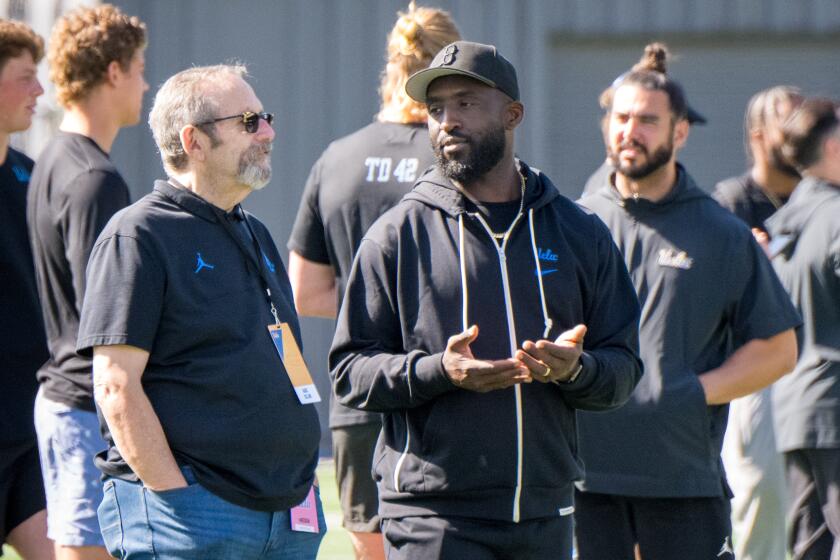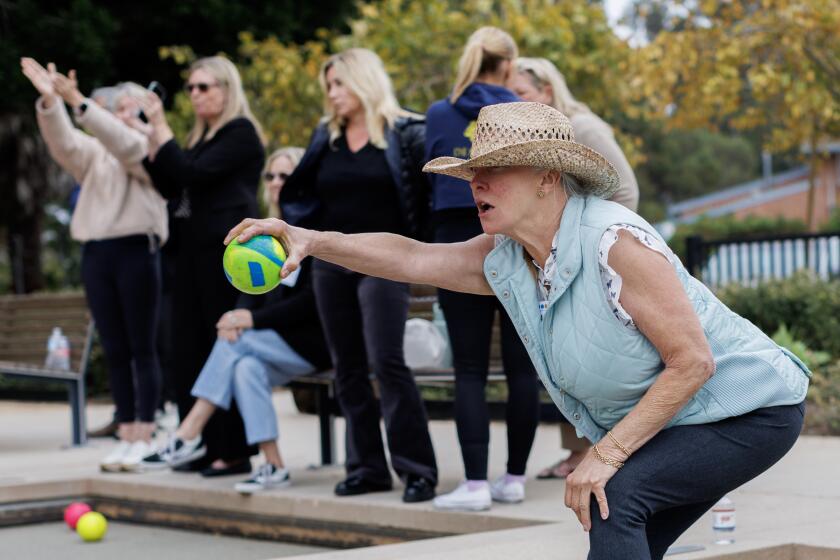Monday Evening Quarterback
It’s a fall Monday, the sun is down, the pulse rate is up, and millions of Americans are tuning in to “Monday Night Football,” the longest-running live prime-time show in television history.
Filling the air is the familiar baritone of play-by-play announcer Al Michaels. Bank of America Stadium, home of the Carolina Panthers, is filled to capacity and rocking. Twenty TV cameras are rolling, poised to capture the action from every conceivable angle. A crescendo is building.
Are you ready for some ... roast beef on a French roll?
Hey, a guy’s got to eat, even when 20 million people are listening to his every word. It’s 9 p.m., and Michaels, John Madden and the crew have been in and out of production meetings for the last 12 hours. Michaels typically snacks during the first half, washing down Snackwell cookies, Junior Mints and green grapes with cup after cup of coffee, then has a light dinner in the second half, stealing bites during commercials. He’s a discreet eater and a picky one; he never lets a vegetable touch his plate, let alone his lips.
The millions of football fans watching the game have no idea that Michaels is eating dinner along with them. After more than 40 years in the business, the last 19 with “Monday Night Football,” his delivery is so fluid, so close to flawless, it’s hard to believe that he’s concentrating on anything but what’s happening on the field.
But he is. In fact, it’s astounding he has time to glance at the field at all, what with all the information flying his way. He’s talking through his headset to the main production truck and to statistician Steve Hirdt in another truck, interpreting hand signals from the spotter just off camera to his left, and being handed a steady stream of in-game promos on index cards from the stage manager.
In front of Michaels are 14 monitors -- seven for him, seven duplicates for Madden -- each showing a different aspect of the game, among them team stats, individual stats, the game clock, what the network is showing, a shot looking back at them in the booth. Each also has his own Telestrator, allowing him to use a finger to draw on the screen.
The job of processing all that information, producer Fred Gaudelli said, is for Michaels like “being an air-traffic controller who’s trying to land his own plane at the same time.”
Last Monday, for the first time in its 35-year history, “Monday Night Football” allowed a reporter to observe a broadcast from the booth. The program is in its last season with ABC and next year will switch to ESPN, bringing Michaels along for the ride. Madden will head to NBC next season for “Sunday Night Football.” As for the rest of the “Monday Night Football” crew -- a group 75 strong on game day -- the future is uncertain. Everyone’s treating this season as a last hurrah.
Are you ready for some ... shameless lobbying?
About an hour before kickoff, a member of the officiating crew working the game makes his way up to the broadcast booth and introduces himself to Michaels. The zebra wants to make sure Michaels knows what the officials will be watching for, what calls could arise. Everyone wants to be understood, everyone wants to be heard, and Michaels is the main conduit between the league and millions of viewers.
Maybe that’s why it’s common for coaches to clue in Michaels and Madden on what plays they’ll see in the game, or even the deficiencies of players. Often, the announcers have been told long before kickoff what the first play, or first series of plays, will be. Players also saunter over and introduce themselves to Michaels and Madden as the two separately work the field about an hour before kickoff.
In Carolina last Monday, Michaels spent a few minutes before the game chatting with Green Bay rookie quarterback Aaron Rodgers, who was wide-eyed and smiling. Madden was across the field investigating what songs a Carolina player had on his iPod. (“Didn’t even recognize one of them,” Madden reported later.)
Both men get the celebrity treatment at every game. They arrive by limousine, wear credentials that get them just about anywhere and draw a crowd of onlookers wherever they go. By agreement with the league, their booth is on the 50-yard line at every stadium. Not a bad gig.
Are you ready for some ... sign language?
Sitting to the left of Michaels is a man holding a “spotting board,” which looks like a homemade periodic table. Study the cheat sheet’s 10-point type and you’ll notice a separate box is assigned to each player on both teams, from the stars to the scrubs, and each contains a player’s height, weight, years of experience, and so on. The boxes also feature a couple of fast facts about the player (such as, Carolina returner Rod Smart went by “He Hate Me” in the XFL) so Michaels will always have an interesting factoid at the ready.
But reading that fine print from a distance is almost impossible, especially in a darkened booth. Michaels has long since committed those anecdotes and factoids to memory. The value of the spotting board is that it allows announcers to identify players on the air a half-instant after they make or miss a play. Michaels usually sits during the broadcast, and Madden typically stands. They use the same stools for every game.
Hunched over the board is “Malibu” Kelly Hayes, who has been Michaels’ spotter for every football game since 1978. Hayes acts as another set of eyes, wordlessly working the board like a court stenographer, tapping the names of, say, the intended receiver, the defender who knocked the ball away and the defensive end pressuring the quarterback in rapid succession. Michaels catches it in his peripheral vision and relays it to the viewer.
“We’ve been working together so long it’s pretty intuitive now,” said Hayes, who grew up in Malibu, hence the nickname from Michaels. “I know where he’s going, and he knows where I’m going.”
Sitting next to Hayes, and behind the black curtain to Madden’s right, are a pair of statisticians who write numbers and notes on index cards and hold them up. “That was a horse collar on GB!” one scribbles as soon as the yellow flag touches the turf. The information flow is constant.
The most impressive thing about this elaborate dance? No one comes away with crushed toes.
Are you ready for some ... controlled chaos?
Parked in the bowels of the stadium are four production trucks, the largest of which is the nerve center for the show. Producer Gaudelli and director Drew Esocoff sit in there, as do several other key technicians. They study a wall of TVs -- at least three dozen, each about the size of a CD case -- and make hundreds of rapid-fire decisions in what at times sounds like a foreign tongue. The show is cut and the audio is mixed live, while they’re on the air. There’s no luxury of post-production to fix mistakes.
At one point in last Monday’s game, the crew wanted to give some insight on what separates Green Bay’s Brett Favre from other quarterbacks such as Carolina’s Jake Delhomme. A cameraman got a shot during warmups of Favre’s massive hand engulfing the football.
Michaels looked at the shot before the game, liked it, and decided to work it into the show. Then, during the broadcast, he dropped a few subtle hints on the subject, and the folks in the production truck seamlessly weaved it into the broadcast. The chatter in the truck went something like this:
Esocoff: Camera 11, get me Brett’s throwing hand.
Gaudelli: Guys, cue up Favre’s hand.
Esocoff: Camera 8, find me Delhomme.
Gaudelli: Cue up Delhomme’s fingers. Cue ‘em up!
Just think: That feature lasted roughly five seconds. So that’s five seconds down, only 10,795 seconds of a three-hour broadcast left to fill.
Are you ready for some ... mistakes?
They do happen, although they’re rare. When Michaels realizes he has made an error, such as misidentifying a player, he always corrects himself. If anything, he’s a stickler for the facts. He tries not to deal in NFL gossip, so, when he’s preparing for a game, he’ll stop reading a story if he questions the source. He doesn’t want to clutter his mind with bad information, lest something slip out on the air.
“My thing is, just try to get it right,” said Michaels, 60. “I’ve never been a guy who has to get it first. There’s much too much attention paid in this business on ‘You heard it here first, as reported by so and so.’ You don’t have to get it first, but you do have to get it right.”
Michaels is a news junkie, and not just sports news. When he gets up around 5 a.m. each day, he either heads for the Internet or scans the four newspapers delivered to his Los Angeles home: the Los Angeles Times, the New York Times, Wall Street Journal and USA Today. He always reads the front page, the business section and, of course, sports. Mark Mandel, the show’s media-relations director, said it’s common for him to call Michaels from New York around 7 a.m. in L.A.
“By that time,” Mandel said, “Al already knows more about what’s going on in the world than I do.”
And in Michaels’ world, sports is entertainment, nothing more. He doesn’t hyperventilate with the microphone the way some announcers do. Even his most memorable call -- “Do you believe in miracles?” when the U.S. hockey team beat the Soviet Union in the 1980 Olympics -- seems measured and even-keeled in today’s I-can-scream-louder-than-you world of sports broadcasting.
“The only thing that I find to be disturbing is when people spend too much of their lives enveloped in sports,” he said. “There’s nothing more ridiculous to me than when there’s a national tragedy -- a 9/11, a Hurricane Katrina -- and people say, ‘Well, this puts everything in perspective.’ No it doesn’t. Sports should always be in perspective.”
The TV industry is imprinted on Michaels’ DNA. His son, Steve, runs a production company in Hollywood, and his daughter, Jennifer, is a CBS publicist. His brother, David, has been a producer for NBC Sports for 15 years. Their father, Jay, now deceased, was an agent who helped start Trans World International, the TV arm of the late Mark McCormack’s International Management Group; and their mother, Lila, chose contestants for game shows, among them “Win, Lose or Draw” and “The Joker’s Wild.”
Al and David Michaels grew up in a one-bedroom apartment in Brooklyn. They slept in the bedroom; their parents slept on a pull-out couch. The family lived only blocks from Ebbets Field, where the Dodgers played, and the boys and their father spent every weekend either playing or attending football, basketball, baseball and hockey games.
“All I could think about when I was a kid was, ‘Can you imagine having a job where you got to go to every game for free?’ ” he said. “That was the impetus.”
Are you ready for some ... golf?
From Tuesday through Friday, Michaels is more likely on a fairway than in the film room. Yes, he’s a perfectionist. Yes, he takes his job seriously. But like an athlete peaking for an event, he knows when to gear up to do his job. He might watch a team’s previous three games and read some newspaper clips during the week leading up to the game, but he doesn’t turn on the intense focus until the weekend.
He usually flies Saturday to the city that’s playing host to the game, then, along with Madden, meets with players and coaches over the weekend. That provides them all the information they need.
“I’ve got to be able to distinguish between what’s important, what’s interesting, what’s informative, what helps the viewer enjoy the game, and what’s yak, yak, yak,” Michaels said.
In his first national TV appearance, Michaels prayed he could keep his composure enough to yak, yak, yak. It was 1972, and he was the 27-year-old announcer for the Cincinnati Reds, who made it to the World Series. Back then, NBC covered the games by teaming the home team’s local announcers with Curt Gowdy.
“The camera widens and he’s going to bring me in as the young announcer for the Cincinnati Reds,” Michaels recalled. “And all I can think about is, ‘Please, God, when I open my mouth, let air come out.’ ”
Air did come out. And, 33 years later, America is still listening.
*
(BEGIN TEXT OF INFOBOX)
Talking points
A look at Al Michaels’ personal and professional career:
Age: 60.
* Born: Brooklyn, N.Y.
* Resides: Los Angeles.
* High school: Played baseball and football at L.A. Hamilton High; graduated in 1962.
* College: Majored in radio and television and minored in journalism at Arizona State.
* First job: Broadcast baseball games for the Hawaii Islanders of the Pacific Coast League in 1968. He also did football and basketball play-by-play for the University of Hawaii.
* First major league job: At 26, became the No. 1 broadcaster for the Cincinnati Reds in 1971.
* UCLA connection: Broadcast Bruin games from 1973 to ’75.
* Giant move: In 1974, Michaels became the San Francisco Giants’ television and radio broadcaster, a job he held until signing with ABC Sports in January 1977.
* “Monday Night Football”: Has been the play-by-play announcer since 1986.
* Honors: Twice (1983 and 1986) has been selected national sportscaster of the year by the electronic and print media. In 1989, he won his second Emmy award for “outstanding sports personality.”
Los Angeles Times
More to Read
Get our high school sports newsletter
Prep Rally is devoted to the SoCal high school sports experience, bringing you scores, stories and a behind-the-scenes look at what makes prep sports so popular.
You may occasionally receive promotional content from the Los Angeles Times.







